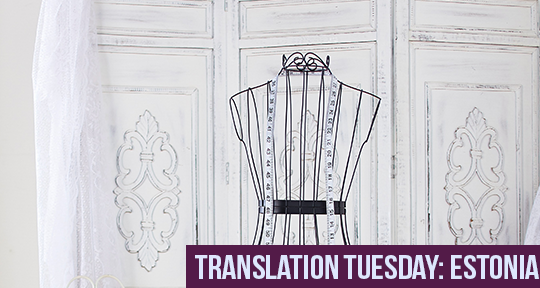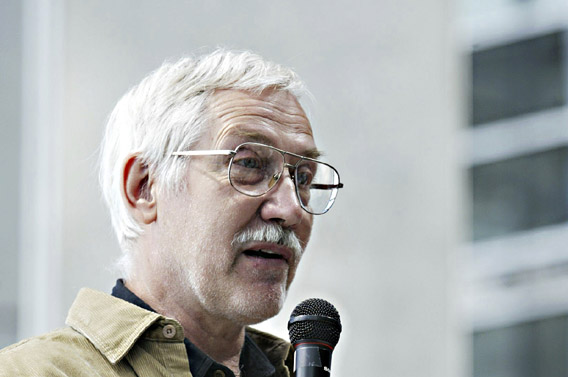Experience the world anew through non-human eyes in “Vivarium,” our Spring 2023 issue! From macaques to marmots, muntjacs to mosshoppers and microscopic prokaryotes, a superabundance of literary life overflows from 30 different countries. In this thriving biosphere, you’ll find work from Estonia and Oman flowering in the same soil as Alaa Abu Asad’s Wild Plants and our first entry from Bolivia via Pulitzer Prizewinner Forrest Gander. The same Pangaean ecosystem sustains our animal-themed special feature headlined by Yolanda González, recipient of the 2001 Premio Café Gijón Prize, and 2018 Booker International longlistee Wu Ming-Yi. Alongside these, there are the always thought-provoking words of Italian poet Franca Mancinelli, which bloom in both the Interview and Poetry section—the latter also shelters Fernando Pessoa, whose brilliant co-translators Margaret Jull Costa and Patricio Ferrari have rendered him in one of his most mordant heteronyms, Álvaro de Campos.
Language: Estonian
Our Spring 2023 Edition Is Here!

Featuring Fernando Pessoa, Franca Mancinelli, Wu Ming-Yi, and Yolanda González in our animal-themed special feature
Translation Tuesday: An Extract from House of Fashion by Maimu Berg

These trends tended to be the same as the trends available in the West a year before, just that the designs had been made more boring and less sexy
This Translation Tuesday, enter the circles that defined Soviet-era fashion with Estonian novelist and ex-journalist Maimu Berg, whose novel House of Fashion fictionalises the strange sartorial world that she herself had inhabited when she worked for the Tallinn-based fashion magazine Siluett. In these extracts, we follow the wide-eyed Betti as she cavorts with a cast of fashion designers, post-censors from the Ministry of Culture, models and photographers, all this time wryly defending her role as a writer in this grand, far-flung industry. With D. E. Hurford’s translation, the energy of a lesser-known aspect in Soviet history is unveiled to English readers who are sure to be baffled by some of these playful anecdotes and the inside scoop.
Soviet Fashion.
To Moscow, to Moscow.
Drug-addict models.
Everyone who lived in the Soviet Union nurtured a pious dream of visiting Moscow. At least that was what most Muscovites thought. When an invitation was sent from Moscow to the houses of fashion in, say, Tashkent or Alma-Ata, to come and see the latest developments in Soviet fashion, scuffles would break out. Anyone with even the smallest bit of status felt that she should be the one to go to Moscow, the navel of the world, where smoked sausage, tinned crab, Polish scent, East German hair products, mother-of-pearl lipstick, and a preposterous selection of handbags, jumpers and winter boots could be bought. She should be the one who, after a dull and tedious meeting at the Soviet Union’s head house of fashion, should get to trudge through crowded tunnels full of pongy dour people and go “from GUM to TsUM” (the two big Moscow department stores of the time) and to fabled shops like Vanda, Vlasta and Leipzig, where the peoples’ republics sold their own products, mainly cosmetics. No shopper really thought about the actual meaning of “people’s republic”; any Soviet woman who was the least clued-up associated the phrase with those particular stores near the centre of Moscow. In the morning before these wondrous shops opened, there would be a queue of women patiently snaking its way in front of the doors. Technically the queuing had started back in their home cities—the provincial houses of fashion had waiting lists for those wanting a trip to Moscow and there could be a wait of up to three or four years before it was your turn.
A similar sort of passion also inflamed the Tallinn House of Fashion in a minor way, but inversely. Usually, at the coldest point of the year, no one had any desire to trundle off in the train to Moscow, go to considerable trouble to stay at a hotel (you might well have made a reservation, but that didn’t guarantee you anything), visit all the shops needed to work through the order list given to you by friends and colleagues, cover huge distances by metro and trolleybus, and doze off in lectures presenting the clothing models redesigned by Moscow fashion designers and stylised to fit Soviet fashion, accompanied by some silly nonsense about the latest trends in Soviet fashion. These trends tended to be the same as the trends available in the West a year before, just that the designs had been made more boring and less sexy. Visiting Moscow was nice when it was warm and when fashion shows were on the agenda, whether those of the Moscow house of fashion or, even better, smaller fashion shows by different embassies, or by some Western firm that had gone to the trouble and expense of coming to the bleak plains of Sarmatia in the hope of sooner or later striking it lucky and the vast, gaping emptiness of the Russian market opening up just for them.
The first time Betti ended up in Moscow as a staff member at the Tallinn House of Fashion she travelled with head designer Milla Säga, a striking lady, tall, alert and strong, with a completely un-Estonian nose and stylishly dressed, as befitted her profession, and on that occasion dressed particularly strikingly. They headed for Hotel Berlin, whose heyday was long past—the last time there had been carp swimming in the marble basin of its fountain, for guests to select one and get most of it at a formal dinner in the ostentatiously handsome hotel restaurant, had probably been during Lenin’s New Economic Policy of the 1920s. By now, however, the carp had long been eaten and the basin drained; now the hotel lobby stank of people and grain coffee over-sweetened with condensed milk—breakfast was being served. There was no hope of getting a room so early, but even more tragically, it seemed no reservation for the Tallinn House of Fashion could be found, even though the receptionist flicked back and forth through the worn bookings diary and even rang somewhere to ask.
Milla Säga, this sparkling lady who spoke Russian with an Estonian accent that sounded sweet in Betti’s ears and who was generally quite loud anyway, sharpened the tone by pointing to the dried-up fountain and informing all who wished to hear that it was “definitely here that she’d booked”. By an unfortunate error of Russian verb conjugation, however, she managed to inform everyone that it was definitely here she’d peed. The receptionist heroically stifled the laugh that emerged as her mind formed an image of the tall, elegant and self-confident Milla Säga tinkling the marble of the hotel fountain. However, she did understand what Säga meant to say, which was that she had personally sent the hotel a letter asking to book rooms for us. On this occasion, a Baltic accent was useful; without it the phone call probably wouldn’t have been made, and after a lot of faffing around and handing out copies of Siluett magazine (and some 25-rouble notes “getting lost” between their pages) Milla and Betti finally got the longed-for keys and clattered up in the lift to their floor. READ MORE…
The Queen’s Argot: The Language of Chess Around the World

Players worldwide understand the pieces . . . but our understanding . . . depends in part on what we call them.
Netflix miniseries The Queen’s Gambit illustrated the international culture of chess. As it turns out, the game’s spread around the globe is a story of translation. In this brisk and brainy rundown, Editor-at-Large Allison Braden tackles its evolution through time and space, setting up a board in which pawns can be farmers, bishops can be fools, and queens can be counselors.
In December of last year, Netflix miniseries The Queen’s Gambit smashed viewership records for a limited-run series on the site. In the show’s first month of streaming, over 62 million people around the world tuned in to the story of a young woman who overcomes several challenges in her quest to become a world chess champion in the 1960s. The series was based on Walter Tevis’s 1983 novel of the same name, and like readers before them, viewers rooted for plucky chess prodigy Beth Harmon. Her eventual triumph was, for many, a bright spot at the end of a long and difficult year.
You won’t become a grandmaster by watching the series. (In fact, one of the only aspects of the show that pro chess players took issue with was the speed of the games. In a concession to viewers, they were faster paced than matches at real tournaments.) But The Queen’s Gambit is a crash course in the culture of chess. It’s fiercely competitive, requires visual and strategic intelligence, and remains extremely male dominated (despite studies showing men aren’t inherently better at the game). Chess is also truly universal—and where there’s an international pastime, there are translators.
In the show, Harmon travels to Mexico, France, and the USSR. As her skill grows, her competitors increasingly hail from foreign countries, and as it becomes clear that the ultimate test of her ability will come in Moscow, she begins to study Russian. In the heady final scenes, commentators relay her moves in a variety of languages for listeners around the world. After The Queen’s Gambit was released, interest in chess boomed. One of the most popular ways to play is online. Chess.com boasts users from dozens of countries, and they can all play one other. Like many sports, chess transcends language; in a way, it is its own language. Players worldwide understand the pieces: the king’s hesitance, the queen’s might. The bishop, which can only move diagonally, speaks his own sideways tongue. READ MORE…
Riveting Reviews: An interview with the European Literature Network

Our goal is to support others working in this area: publishers, translators, the trade, and bring them all together.
Over the past ten years the European Literature Network—a tiny organization, run on a shoestring budget—has firmly established itself as the foremost champion of European writing in the UK. Asymptote’s editor-at-large for Slovakia, Julia Sherwood, caught up with the network’s founder and driving force, Rosie Goldsmith, and editor, West Camel.
Julia Sherwood (JS): Rosie, your name has become synonymous with European literature in the UK. You’ve chaired numerous European Literature Nights and, more recently, the jury of the EBRD Literature Prize. I can barely imagine the UK without your organization but some Asymptote readers, who are based elsewhere, may not be so familiar with what you do. Can you tell us what got you to start European Literature Network and what it does?
Rosie Goldsmith (RG): It all started with the European Literature Night (ELN) at the British Library in 2009, hence the rather long name, European Literature Network. I was asked to chair that and be one of the judges. We had to select from about 50-70 texts. Initially it was just me—I’d just left my job with the BBC, I had time on my hands, and when ELN was over, I felt that the momentum should be kept. After a trip to Brussels for the European Union Literature Prize with some twenty editors and publishers, I suggested that we keep this going. So many great books are being published but few people know about them, so I decided to do something I care passionately about and help everyone in the trade connect and get these books to the public. I organized the first meeting at the Goethe-Institut London and later we started meeting at Europe House, which was run by the European Commission but has sadly ceased to operate after Brexit. READ MORE…
Jaan Kaplinski was born to an Estonian mother and Polish father in 1941 in Tartu, Estonia. His father was arrested by the NKVD for ‘possible subversive anti-Soviet activity’ and disappeared in the Gulag archipelago during the war, probably dying in 1943. Says Kaplinski: “He saw me, but I have no memory of having seen him.”


